Text
FEMA is doing an emergency alert test on all TVs, radios, and cell phones on October 4, 2023, at approximately 2:20pm ET.
If you live in the US and you have a phone you need to keep secret for any reason, make sure that it is turned off at this time.
Yes, I'm doing this months in advance, and yes, my blog has very little reach, but I figure better to post about it more than less.
Please reblog and add better tags than mine, I'm bad at tags.
137K notes
·
View notes
Photo


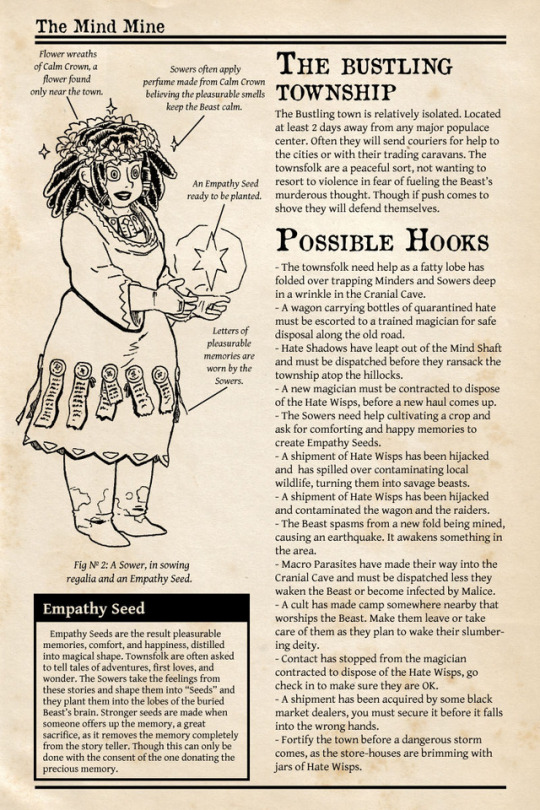

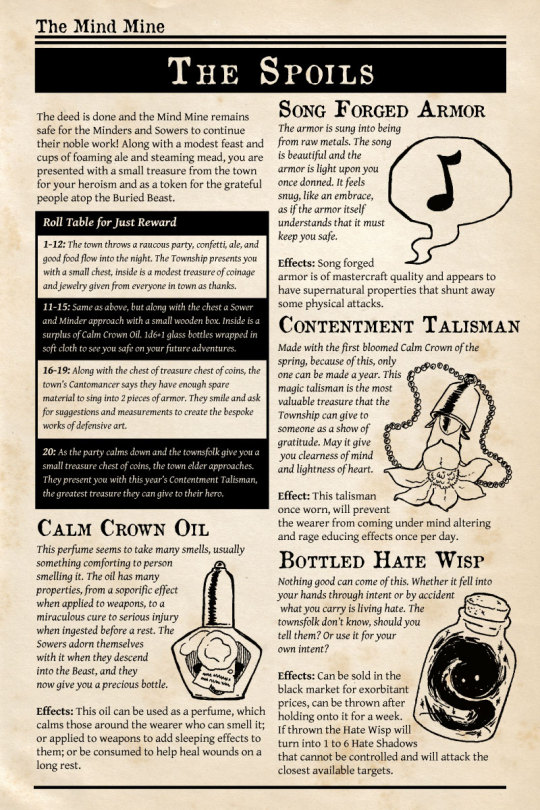

The full Mind Mine Adventure Seed is up! You guys can download the full PDF for FREE here at my Gumroad, or here at my Patreon!
Special thanks to all of my patrons that made this all possible!
-M
32K notes
·
View notes
Text
I have tragically yet seen a A:TLA crack fic where canon! sokka gets suck in a modern, no powers AU. While juggling his counter identity, the everlasting bullshit that's American high school, bumbling at modern devices and slang, avoiding his sister and dad of this universe, and trying to find his way home... he's just like, huh. It's nice to have a hot minute thats not being a child soldier. And thus begins Sokka's journey doing absolutely batshit insanity thinking its even remotely in the ballpark of normal which includes but is not limited to:
• Joining the cheerleaders thinking that they’re like the kyoshi warriors. Furthermore seeing the make-up and skirt as integral to the art. (He's not wrong, and pulls it off amazingly)
• Met in universe Zuko, whos currently a jerk, but isn't also a human flamethrower and literally hunting him down. Sokka's just normal about it while Zuko insistences they're rivals. They fight in the hallways at least once (less a fight and more of zuko frantically throwing punches and Sukka ducking and blocking with the utmost and infuriating chill.)
• Wants money. So what does he do? Goes to a karate competition. Wins. Then proceeds not to tell anyone. Not out of any actual secrecy but because this is pretty standard Gaang stuff back home.
Que the frantic sensei that arrives at the door answered by the very confused Katara and Hakoda.
•Gets more into martial arts and literally freaking everyone out. Turns out, spending the majority of your short little life fighting, keeping up with, beating, and trying to survive from not only full grown masters, but also masters that can control forces of nature plus maybe a spirit or two makes you pretty damn good at fighting.
• Casual parkour. Twenty-four seven. On roofs. Climbing up brick walls. Gravity defying jumps. Ridiculous reflexes.
Naturally the modern him that lands in his universe is just screaming 24/7. But hey, they both go home in the end. Canon sokka gets a break, modern sokka gets a crisis, as a treat.
8K notes
·
View notes
Text
D&D: How to Use Character Arcs as a Dungeon Master
In my previous post on character arcs, I talked about how a player should determine how they want their character’s arc to begin and end. It was from a player’s perspective. But how does a DM write an adventure that will make that player’s arc happen?
First, get the information you need. Ask your players to each determine how their characters will begin the campaign and how they want them to change by the end of it. Then ask for copies of their character’s traits, flaws, ideals, and bonds. Note whether a player’s character is going to die tragically and if they are okay with that. With this information, you can give the players what I call a moral quandary, personalized for their own character’s arc. A moral quandary is giving the player two difficult options that the player must decide how their character would choose. The character should lean to one side of a moral quandary at the beginning of an adventure, but gradually start to lean the other way as their arc comes to completion.
For instance, a cleric might be presented with a choice to kill an evildoer or merely capture them. If the cleric is heading down an arc where their ideal changes from “all life is precious” to “evil must be stopped at all costs” in their character arc is going to make very different choices in that situation depending on where they are on their arc.
Let’s figure out how we can use this info as a DM and where to put moral quandaries using a 9-point story structure. These are not an entire campaign, but you can use each point as a fixed point in the narrative; a story outline based on the characters’ arcs. Plenty of different stuff can happen between each point, but the points must happen to create a robust story.
Call to Action
The player is given an initial call to action. Essentially, a moral quandary disguised as a quest hook. Try to have a separate but related call to action for each player. Ideally, the players should refuse the call to action, as they haven’t been “changed” yet. If they play to their characters’ initial backgrounds and traits, they will refuse the call. You can even enforce this by loading your call with descriptions of how the character is feeling. “You are offended that someone would even offer something so morally reprehensible to you, despite the fact that you could use the money.”
A good-hearted rogue is starting a tragic fall arc and is offered a chance to make millions from some morally questionable actions involving an evil regime, but decides it is wrong. An innocent paladin starting a coming of age arc could be offered a chance to rise against an evil regime, but values their own safety. A studious apprentice wizard starting a corruption arc is offered power in exchange for service to an evil regime, but decides they can get power on their own.
Inciting Incident
Something happens to force the player to action, whether they are ready or not. Try to come up with an inciting incident that involves all of the players, not just one. The inciting incident can act as where the adventuring party finally meets.
The evil regime in the Call to Action ends up invading the players’ quiet suburb to enforce martial law. The players escape or fight back or else they and their loved ones die or are enslaved. The rogue decides to run from their debts by joining the party. The paladin has seen firsthand what the regime can do, and will now join the party to find someone else who can help them stop it. The wizard seeks out more power to stop the regime.
1st Plot Point
The players learn the first shreds of information about the overarching narrative of the campaign. After the inciting incident, some characters might not be convinced and want to turn back. This gives them a reason to continue onward together, as a team. There should be no turning back from the 1st plot point.
Players learn how this evil regime has been spreading across the kingdom. It still holds many mysteries, but its power is great and threatening. Its power is centered in a capital city, which the players now opt to travel to in order to find the things they currently desire.
1st Pinch Point
A pinch point is the first real display of power from the antagonist or opposing force. In D&D this should be actual combat, though it doesn’t have to be. As long as the players see firsthand what the antagonist can do to their characters, this part will add the tension/drama that it should. If you want to have a 1st Pinch Point for each character, then this display of force should directly target the player’s character arc and spark the desire to change through a moral quandary. It’s an awakening. Create tension by ending a session with this pinch point.
The players come across a thieves’ guild run by the evil regime. The rogue takes note of how rich, glamorous, and lawless the life of a criminal is to spark their tragic fall arc. The paladin realizes how deep the corruption of the world runs and sparks their coming of age arc as their innocence starts to fade. The wizard realizes how much resources the evil regime has, and wonders what sorts of power they had in mind for him sparking their corruption arc.
Midpoint
More info is revealed about the antagonist and the perception of the characters change. They have an epiphany and decide to continue onward through their arc. This can, and most likely will, happen at different times for each character and their varying arcs.
The players learn about the leader of the regime. They have been pushed to the breaking point by the regime’s forces. The rogue decides join the regime and start doing crime for the regime and acting as a double agent against the party. The paladin no longer cares about finding someone else to help them stop the regime, vowing to end it themselves. The wizard gets an unholy tome and decides to learn how to make a pact with the demon the regime mentioned to overpower the regime. They are all still heading to the capital, though now with severely divergent goals.
2nd Pinch Point
The antagonist reveals their full power and threatens the completion of the characters’ arcs. The entire party should, in general, be at their lowest moment and completely without hope. This should happen at the same time for everyone. Ideally, end a session with this pinch point to create a cliffhanger and highlight the hopelessness.
The players reach the capital of the evil regime. The rogue is faced with a moral test, where they will be offered riches and allowed to live if they rat out their adventuring party. They choose to take the offer and are betrayed by the regime’s leader and sentenced to death anyway. The paladin comes face to face with the regime’s leader after being ratted out by the rogue. They fail the encounter and barely manage to escape with their life. The wizard is also defeated and their unholy tome is destroyed in the battle. The rogue is imprisoned and the paladin and rogue escape the leader and are being hunted in the capital.
2nd Plot Point
The last piece of the puzzle has come together in the second plot point. The characters finish their arc and learn how to overcome the antagonist. This can happen at different points and doesn’t have to happen quickly. For a tragic character, this is the part where they finally meet their end. Tragic characters fail to change or their change is self-destructive and they fail to overcome the antagonist of the story (tragic, isn’t it?). Think of this part as a moral quandary that characters’ finally “know the answer” to, as far as their character arc is concerned.
The rogue tries to escape, succeeds, but heads back to the thieves’ guild instead of his adventuring allies, and they ultimately betray and kill him. The paladin’s innocence is shattered and they gather rebel forces over time to take on the regime’s leader, becoming a leader themselves. They also find an unlikely ally in the wizard, who has finally succumbed to evil. The wizard still doesn’t know how to summon the demon, but they have already gotten a taste of evil’s power by performing vile rituals on captured regime members and will now use their power for vengeance against the regime’s leader.
Climax
The characters finally face off with the antagonist. The promise set out at the beginning of the campaign is fulfilled. The characters, having completed their arcs, are now changed enough to be able to defeat the antagonist. This should be the players at their most powerful and should be the most epic battle to take place in the campaign.
The paladin’s rebel army and the wizard’s evil magic face off against the evil regime’s leader. The battle is long and epic, but the characters succeed, freeing the kingdom of the evil regime.
Resolution
The game shouldn’t abruptly end after the antagonist is defeated! There needs to be closure. The players’ characters find out the results and the aftermath of defeating the antagonist, for better or for worse. In the case of an ongoing game, you should now set up the next campaign here.
The paladin and wizard regard each other as unsteady allies who no longer have a common enemy. The wizard seeks more power, even seeking to possibly usurp the void of power left from the regime’s defeat. The paladin and their rebel army gather in defiance of the wizard. The paladin tells the wizard to leave the kingdom and not threaten anyone with their evil, else the paladin will smite them down. The wizard, not having many spells left after the battle and not being ready to face an entire army, teleports away to parts unknown with a puff of green smoke. The paladin is placed in power, and the wizard now acts as a looming threat. Perhaps an NPC and villain for the next campaign?
This character arc outline is not cut-and-dry. You should use it as a guide, not a rule. Some characters might abruptly choose to change. Some will reach different parts of the outline at different times or out of order. Some characters might waffle between two sides of their arc before deciding which side they want to be on. But the more you talk to your players about it, the easier it is to come up with a generalized plan for your campaign’s story. Heck, your story might even change from what you initially intended by the end of it (a character with a bad roll can still end up dying before even finishing their arc!) But hopefully this will aid you in making the players love their characters even more and have fun as they grow and change in your campaign’s world. That’s what it’s all about, after all.
2K notes
·
View notes
Text
Basically, the reason you’re having trouble picturing how your D&D character can possibly use a dagger effectively in a fight is because most “daggers” you see in contemporary fantasy media are based on modern combat knives, which have an average blade length (note: not total length – “blade length” means not including the handle) of around seven inches.
Historically, your average dagger that was actually meant to be used in a fight had a blade length of around twelve inches, and blade lengths of up to fifteen inches were by no means uncommon – though toward the upper part of that range you start to get into sword nerd arguments about the difference between a dagger and a shortsword.
So basically, your rogue’s dagger is probably much bigger than you think it is!
4K notes
·
View notes
Text
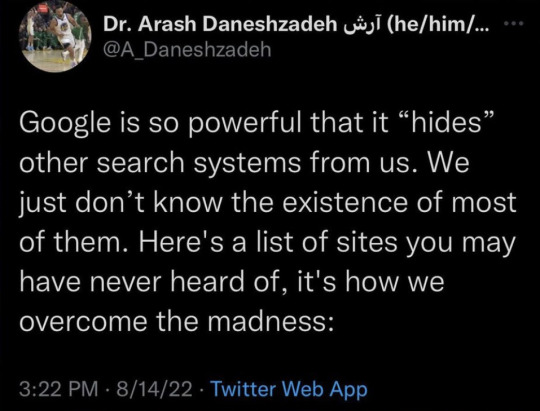

refseek.com
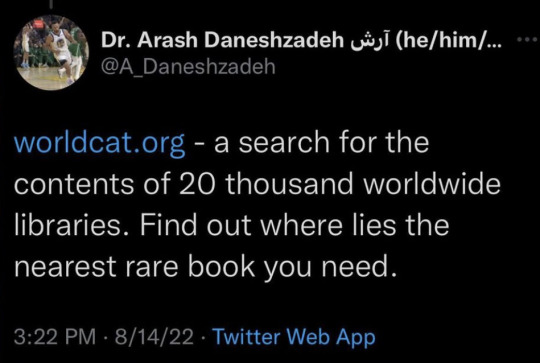
www.worldcat.org/

link.springer.com

http://bioline.org.br/
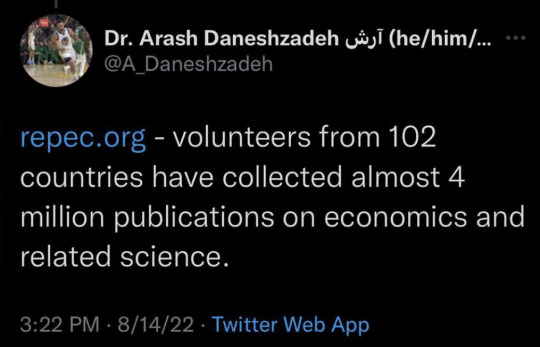
repec.org

science.gov

pdfdrive.com
282K notes
·
View notes
Text
queer is such a good word. im queer as in fuck you. queer as in odd. queer as in fucked-in-the-head. queer as in i hope you choke on it. queer as in a slur i laugh at. queer as in not like you. queer as in none of your business. queer as in a line in the fucking dirt. queer as in we’re here. get used to it. queer as in this is who i am and what i am. queer as in im different and i dont fucking care. queer as in with or without you i exist and ill keep doing it. queer as in queer
44K notes
·
View notes
Text
I see you unfollowing. Good. Don’t fucking stop. This blog is pro choice, pro gay, pro black, pro trans, pro sex work, pro go fuck yourself
32K notes
·
View notes
Text
Unfollow me now if you’re against abortion rights
This is not an invitation to “debate”. A human rights crisis is not up for fucking debate. I don’t want to hear any bullshit from those who have the gall to say they’re pro-life when they don’t give a single, even microscopic shit about the people that anti-abortion measures affect because you high-horse motherfuckers care more about a potential life than one that already exists.
Eat shit.
424 notes
·
View notes
Note
Run, play, burn
Pathfinder, Burning Wheel, and Index Card RPG
oooh those are fun
i'm not super familiar with 2/3 of those
but after some brief googling, I'd say run index card (it seems crunchy enough to make running it pretty easy and simple enough to not require years learning the system), play pathfinder (also crunchy, but like d&d level crunchy, so easier to play than learn to run), and burn burning wheel (both for the amusement factor of burning the burning wheel but also for the fantasy racism that seems baked in)
2 notes
·
View notes
Text
Now let us do “Run, Play, Burn”
It’s just like “F***, Marry, Kill”, except with RPG titles. Send me the name of three RPGs, and I will choose one to GM, one to join as a player, and one to set on fire.
Then reblog this and see what people send you.
322 notes
·
View notes
Text
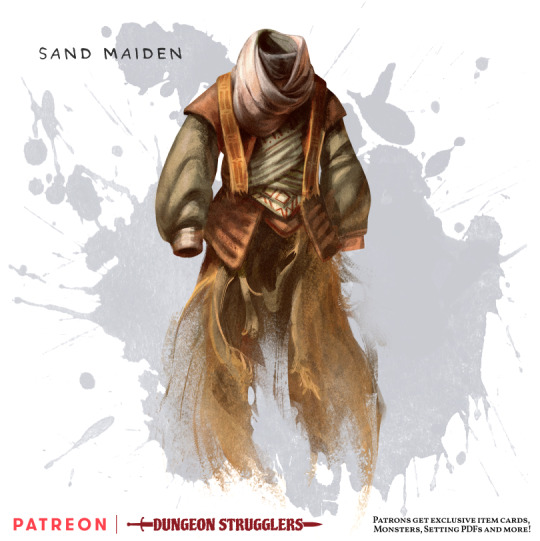
✨New item!✨
Sand Maiden
Armor (padded), very rare (requires attunement)
This padded armor is a billowing assemblage of earth-colored cloth that seems to flow with the wind as if made of sand itself. You have a +1 bonus to AC while wearing this armor. Padded armor normally imposes disadvantage on Dexterity (Stealth) checks, this armor doesn’t.
Additionally, you have advantage on saving throws you make against exhaustion effects due to extreme heat. You gain the ability to glide across the desert, while you are on sand you ignore difficult terrain.
As an action you can transform into the aspect of the sand maiden. For 1 minute, or until you end this transformation with a bonus action, your skin glimmers like a mirage and you move like a swirling sandstorm. While in this state you gain the following benefits:
You have advantage on Dexterity saving throws.
You can move through the space of another creature and pass through small holes, narrow openings, and even mere cracks, though you treat liquids as though they were solid surfaces.
Your movement doesn't provoke opportunity attacks.
Your speed increases by 20 feet.
The armor can't be used this way again until the next dawn.
The Sand Maiden was the ruler of the dunes. Her shifting visage was stunning to behold, appearing to embody the form most desirous to a desperate onlooker. Those who had tested themselves against the vast expanse of her domain and failed would be visited by her in their final moments. Only those who have survived this encounter know what pact is offered in exchange for mercy.
This cloth armor was woven from loose strands of her hair found drifting across the desert contour. Dunefolk treasure this material for its magical properties that bestow a fraction of the maiden’s power upon the wearer.
-
🖌🎨 Like our work? Consider supporting us on Patreon and gain access to the hi-resolution art for over 125 magic items, item cards and card packs, beautiful monster art and stat blocks, monthly setting pdfs with narrative hooks and unique lore, and vote for the content you want to see!🧙♂️
📜 Credit. Art and design by us: the Dungeon Strugglers. Please credit us if you repost elsewhere.
546 notes
·
View notes
Text
some dnd backstory ideas that give your character a reason to leave home that isn’t “everyone in my family died.” (just to say: i have nothing against those backstories (i use them a lot), but its fun to mix it up!)
family/friends/personal
someone close to you is sick. you need to adventure to find a cure
someone stole something important from you and you need to find it
you’ve received a message from a long lost relative and are trying to find them
someone that you love has been kidnapped (maybe you have to earn money to pay a ransom or complete some deed…)
adventuring runs in the family! everyone is expected to complete one quest in their lives
your family/culture sends people out to complete certain tasks when they reach a certain age as a rite of passage
another player’s character saved you in the past so you feel indebted to them and travel with them, protecting/aiding them
there’s a magical drought in your hometown and you have to fix it
your hometown doesn’t have a lot of jobs so you have to travel and send money back home
some childhood friends and you made a “scavenger hunt” where you try and complete a checklist of certain tasks (ie. defeat a barbarian in hand to hand combat, steal x amount of gold, slay a dragon, etc) in an allotted amount of time
quests/jobs
a god/patron has sent you on a quest to do something for them
you’ve been hired by someone to complete a task (and you get sucked into the big adventure along the way)
you’re on a quest for knowledge. maybe it’s to learn the best ways of fighting, maybe it’s something more academic related
your priest received a vision from your god and they sent you on a quest
you’re writing a book about the world and different cultures and you need first hand experience
you’ve found every map you’ve come across is shitty, so you decide to become a cartographer and make your own
you’re a detective who helps solve crimes and need to travel to solve a particular case
you’re a collector of a certain object and travel across the land to find it
you’re apart of an adventuring academy and have to complete a quest to graduate
you’re an artisan and you travel with your wares, trying to sell them. alternatively, you’re trying to spread word of your business and gain new business partners
you worked at a tavern your whole life where an old bard would sing songs of their adventuring party and that inspired you to go and do some adventuring of your own
feel free to add some of your own!
38K notes
·
View notes
Text
Worldbuilding stuff:
If your story has an idle nobility class, their culture shouldn't just be different from the general population, it should be an over-the-top caricature of the common folks' culture. Whatever the population generally agrees is ideal, fair, admirable, or good, the nobility will take into stupid extremes.
Contrary to the beliefs of many, people are actually not at all happy when they're idle - a person with no assigned task or duty will go out of their way to come up with one. And all around the world, whenever there's been an upper class with nothing to do, they've started to compete with each other over stupid shit, but always stupid shit that the culture they live in considers positive qualities.
From the noblemen in Europe challenging each other to a possibly lethal duel over insulting someone's hat, to a Chinese noblewoman being moved to tears by the beauty of someone's calligraphy, bored elites everywhere have always wanted to outdo each other in their expressions of possessing all the noble traits that this culture in particular holds in value.
You can, and should, use this as a way to highlight what the actual values of this society is. In a setting where being religious is held as an admirable trait, there is nobility coming up with new ways to one-up each other in their expressions of worship. Society that values art and music will have them competing over who hires the most artists, and who employs the most talented musicians. Aggressive, war-like people will have fuels to the fucking death over a stupid hat.
Literally anything can be competed in, and bored people with far too much time and money in their hands will become competitive over the most ridiculous things. This isn't just an useful tool in worldbuilding, but also a fun one.
38K notes
·
View notes
Note
46?
Torna a casa by Måneskin!
2 notes
·
View notes
Text
spotify wrapped is HERE! send me a number 1-100 and I’ll tell you the song it corresponds with on my top 100 playlist
125K notes
·
View notes
Text
spotify wrapped is HERE! send me a number 1-100 and I’ll tell you the song it corresponds with on my top 100 playlist
125K notes
·
View notes